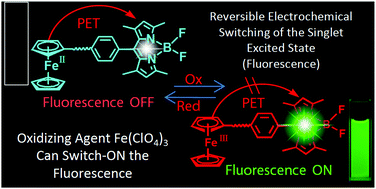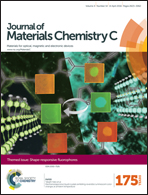Preparation of Bodipy–ferrocene dyads and modulation of the singlet/triplet excited state of bodipy via electron transfer and triplet energy transfer†
Abstract
Modulation of the singlet/triplet excited state of a fluorophore is becoming more important for molecular switches, molecular memory devices, chemical or biological sensors and controllable photodynamic therapy (PDT) etc. Boron-dipyrromethene (Bodipy)–ferrocene (Fc) dyads were prepared for reversible electrochemical switching of the singlet excited state (fluorescence), as well as the triplet excited states of Bodipy. The photophysical properties of the dyads were studied using steady-state UV-vis absorption spectroscopy, fluorescence, electrochemical characterization, time-resolved fluorescence and nanosecond transient absorption spectroscopies. The fluorescence of the Bodipy moieties in the dyads was quenched significantly, due to the photo-induced electron transfer (PET). This conclusion was supported by electrochemical characterization and calculation of the Gibbs free energy changes of PET. We demonstrated that the fluorescence of the Bodipy moiety can be reversibly switched ON and OFF by electrochemical oxidation of the Fc moiety (Fc/Fc+). Furthermore, we proved that the Fc moiety is efficient for quenching of the triplet excited states of Bodipy. Two quenching mechanisms, PET and triplet-triplet-energy transfer (TTET), are responsible for the intramolecular and intermolecular quenching of the triplet excited states of the diiodoBodipy unit.

- This article is part of the themed collection: Shape-Responsive Fluorophores


 Please wait while we load your content...
Please wait while we load your content...